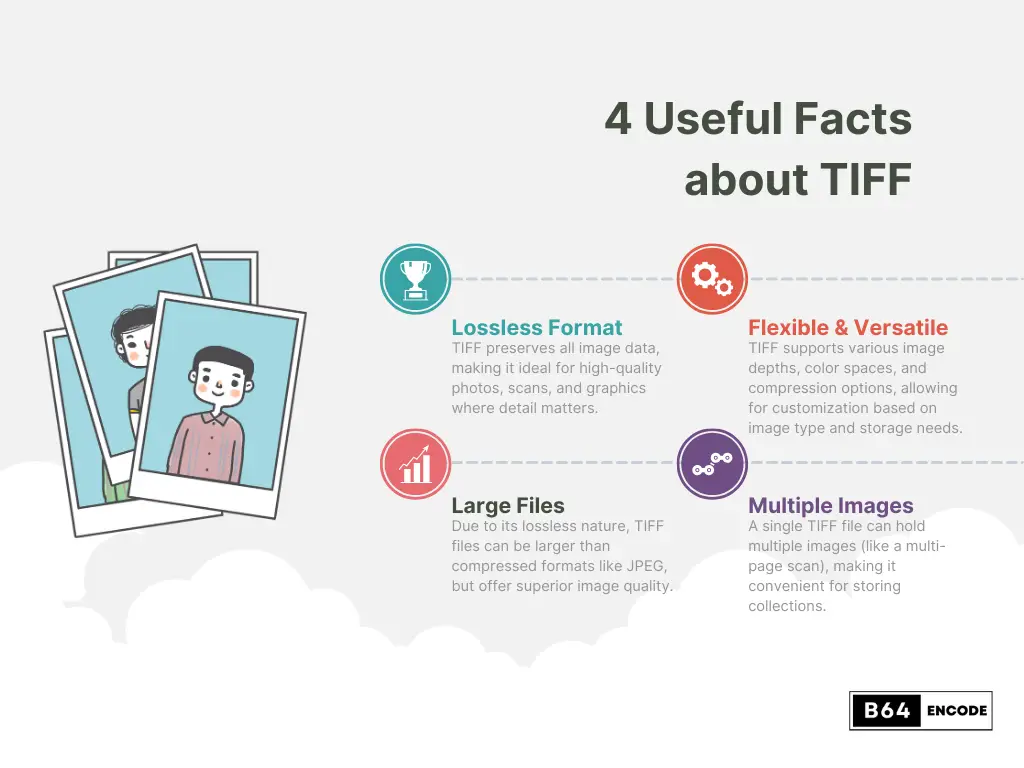Decode Base64-encoded images into TIFF/TIF format effortlessly with our Base64 to TIFF Decoder. Whether you’re working with Base64 data or need to extract images in TIFF/TIF format, our tool simplifies the process. Experience the versatility of Base64-to-TIFF decoding with just a few clicks.
Base64 to TIFF/TIF Converter
Input: Base64 Image
What is Base64?
Base64 is a versatile binary-to-text encoding system designed to represent binary data in a human-readable ASCII format. Widely employed for encoding various types of data, including images and files, Base64 facilitates seamless transmission over text-based platforms such as email or incorporation into URLs. This encoding method serves as a vital tool for efficient data handling and compatibility across diverse digital environments.
What is Base64 Decoding?
The process of turning encoded or compressed data back into its original form or format is known as decoding. Decoding is vital in the context of numerous digital applications for comprehending information that has been previously encoded for transport or storage efficiency. It is a crucial part of data processing that ensures data can be correctly interpreted and used once it has been encoded for various reasons. Decoding is especially important when dealing with encryption, compression, or encoding systems like Base64, where the original data must be recreated from its encoded version.
Base64 decoding is the process of converting Base64-encoded data back into its original binary format. It plays a crucial role in various digital applications, enabling the retrieval and interpretation of information encoded in Base64.
How Does Base64 Decoding Work?
Base64 decoding operates by reversing the encoding process, converting Base64-encoded data back into its original binary form. The following steps outline how Base64 decoding works:
- Parsing into Sextets
- Mapping to Decimal Values
- Combining and Padding
- Conversion to Binary
- Reversing Bit Operations
- Final Output
What is TIFF/TIF?
TIFF (Tagged Image File Format), commonly denoted by the file extension TIF, is a versatile and widely adopted file format designed for storing raster graphics images. Notable features include its support for both compressed and uncompressed image data, allowing users to choose between file size and image quality. The format employs a tagged structure, utilizing metadata tags to specify attributes like resolution, color depth, and more.
TIFF supports a variety of color spaces, including RGB, CMYK, and grayscale, making it suited for a wide range of professional applications such as graphic design, printing, and photography. Its capacity to maintain picture quality without deterioration has contributed to its adoption for archive reasons.

What is the Base64 to TIFF Converter?
When working with image data, you may encounter situations where you need to convert Base64 encoded strings into TIFF format. A Base64 to TIFF converter is a handy tool designed to streamline this process, allowing you to easily transform Base64 encoded data into high-quality TIFF images.
To use this convenient online tool, simply paste your Base64 encoded string into the designated input box, and the converter will quickly generate a TIFF image for you. This user-friendly utility eliminates the need for manual decoding and file conversion, saving you time and effort while ensuring accurate and efficient results.
How Do I Use the Online Base64 to TIFF Image Decoder?
- First, paste the encoded Base64 image.
- No need to press a button, wait until Base64 is decoded. For large photos, this may take longer.
- You can download the result using the Download button.

How does the Base64 to TIFF Converter work?
At the heart of the Base64 to TIFF converter lies the Base64 decoding process, which essentially applies the Base64 encoding algorithm in reverse. The tool first takes the Base64-encoded string as input, then decodes it to retrieve the image’s original binary data. Finally, it uses this binary data to reconstruct and display the image in its visual form, providing you with a high-quality TIFF image as the output. This seamless conversion process ensures that the resulting image maintains its original quality and integrity.
Why would I need to convert Base64 to TIFF?
In certain scenarios, you may encounter limitations or requirements that make it impractical or impossible to work with Base64 encoded images. In such cases, converting these images to TIFF format can offer several benefits.
Firstly, TIFF images may be more easily uploaded or shared in specific systems or platforms where Base64 encoded images are not supported or permitted.
Secondly, TIFF images are human-readable and can be viewed directly, unlike Base64 encoded images, which appear as unintelligible strings of characters.
Lastly, TIFF images generally have a smaller file size compared to their Base64 encoded counterparts, making them more efficient for storage and transmission purposes. By converting Base64 images to TIFF format, you can overcome these limitations and enjoy a more seamless and user-friendly experience.
Is it secure to use your Base64 to TIFF Converter?
When converting images between formats, it’s crucial to ensure the security and privacy of your data. Our Base64 to TIFF converter prioritizes your security with a client-side conversion process. This means that the entire conversion takes place on your device, and the image you upload is never stored on our server. By keeping your data local, you can enjoy peace of mind and enhanced data protection while using our convenient and efficient conversion tool.
Base64 Characters
Uppercase letters, lowercase letters, digits, and two additional characters, comprise the set of 64 ASCII characters used in Base64.
| Value | Character | Binary Value |
|---|---|---|
| 0 | A | 000000 |
| 1 | B | 000001 |
| 2 | C | 000010 |
| 3 | D | 000011 |
| 4 | E | 000100 |
| 5 | F | 000101 |
| 6 | G | 000110 |
| 7 | H | 000111 |
| 8 | I | 001000 |
| 9 | J | 001001 |
| 10 | K | 001010 |
| 11 | L | 001011 |
| 12 | M | 001100 |
| 13 | N | 001101 |
| 14 | O | 001110 |
| 15 | P | 001111 |
| 16 | Q | 010000 |
| 17 | R | 010001 |
| 18 | S | 010010 |
| 19 | T | 010011 |
| 20 | U | 010100 |
| 21 | V | 010101 |
| 22 | W | 010110 |
| 23 | X | 010111 |
| 24 | Y | 011000 |
| 25 | Z | 011001 |
| 26 | a | 011010 |
| 27 | b | 011011 |
| 28 | c | 011100 |
| 29 | d | 011101 |
| 30 | e | 011110 |
| 31 | f | 011111 |
| 32 | g | 100000 |
| 33 | h | 100001 |
| 34 | i | 100010 |
| 35 | j | 100011 |
| 36 | k | 100100 |
| 37 | l | 100101 |
| 38 | m | 100110 |
| 39 | n | 100111 |
| 40 | o | 101000 |
| 41 | p | 101001 |
| 42 | q | 101010 |
| 43 | r | 101011 |
| 44 | s | 101100 |
| 45 | t | 101101 |
| 46 | u | 101110 |
| 47 | v | 101111 |
| 48 | w | 110000 |
| 49 | x | 110001 |
| 50 | y | 110010 |
| 51 | z | 110011 |
| 52 | 0 | 110100 |
| 53 | 1 | 110101 |
| 54 | 2 | 110110 |
| 55 | 3 | 110111 |
| 56 | 4 | 111000 |
| 57 | 5 | 111001 |
| 58 | 6 | 111010 |
| 59 | 7 | 111011 |
| 60 | 8 | 111100 |
| 61 | 9 | 111101 |
| 62 | + | 111110 |
| 63 | / | 111111 |







